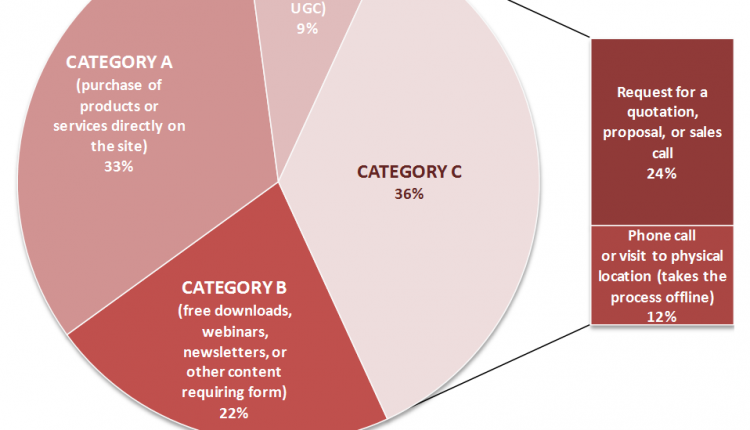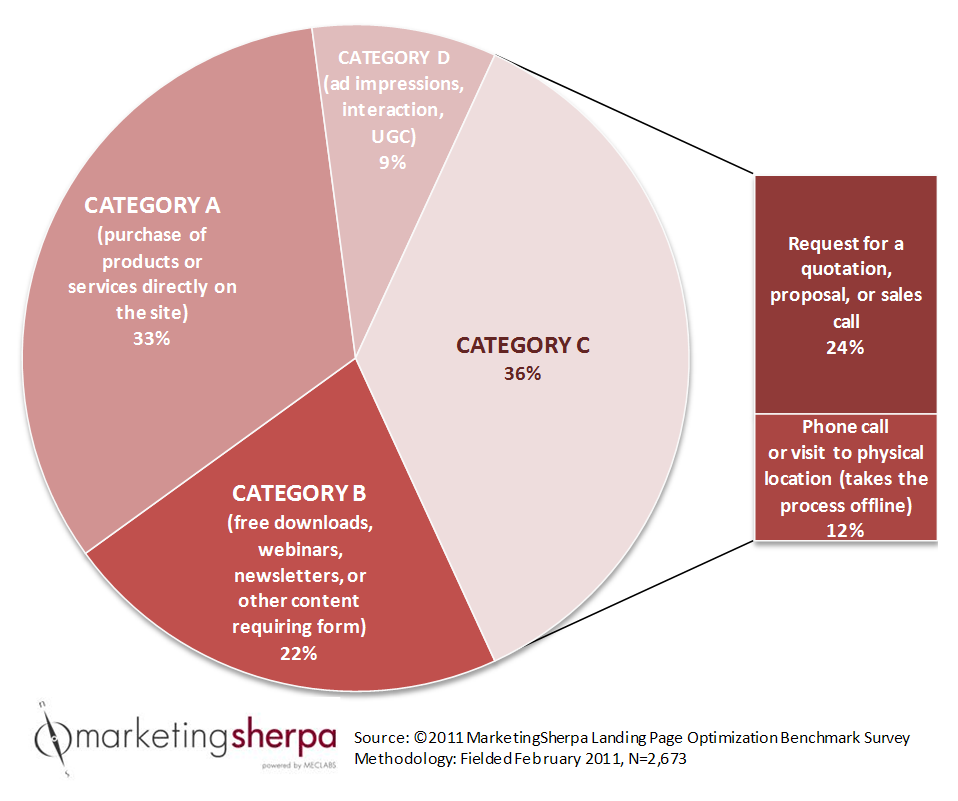In the wake of Director of Editorial Content, Daniel Burstein’s vicious editorial attack on Seth Godin, I thought I would lift up Seth’s spirits by imitation (the highest form of flattery) of his crowdsourced book idea. As I wrapped up the final draft of the 2011 Landing Page Optimization Benchmark Report (BMR), I realized that some of the key insights required a categorization of strategies and tactics based out of a broad spectrum of practices.
Problem: What to name these categories?
Allow me to illustrate. The most tweetable (already tweeted once – thanks, Dan!) phrase in the BMR is perhaps: “LPO is Web design with an agenda.” And that agenda is to achieve a specific objective in terms of the quantity and quality of the visitor response.
An LPO objective must be defined first in terms of the target business outcome: generating a lead, closing a sale, maximizing subscription length, etc. A significant portion of the BMR is dedicated to helping marketers discover ways of getting the visitor to act, which is vastly complex. But defining the objective should be easy. You just have to do it explicitly; otherwise you may end up simply pushing things around on a page without any useful results.
So I asked a few thousand marketers: Which of the following processes/transactions is the primary objective of your organization’s website?
- Purchase of products or services directly on the site
- Request for a quotation, proposal, or sales call
- Free downloads, webinars, newsletters, or other content requiring form submission (lead gen)
- Phone call or visit to physical location (takes the process offline)
- Maximum ad impressions, interaction, or user-generated content
- Providing company or product information
There are certainly other types of objectives that may not neatly fit these categories, and this research does suggest a useful follow-up study. (I was also deliberately devious with the last answer choice. It’s an “objective” that I hear far too often, but it’s probably not your website objective. You are not in the business of providing information, unless you are the Visitors’ Bureau. And even then, your objective is not to provide information. It’s to increase the number of searches, clicks to destination websites, etc. You should be choosing (5). I make a big deal about objectives in the BMR, but I digress…)
Three categories of website objectives by type of exchange
To reduce complexity and allow me to segment respondent data in a useful way, I wanted to reduce further the various attributes of website objectives above into no more than 3 categories that would provide a meaningful way to segment the strategies, tactics, and operational practices of marketers in the BMR. For example, this would allow the reader to distinguish strategies used by marketers who picked (1) from those who picked (3) above.
After some time, these categories took shape. I realized that the key attribute is the type of exchange or transaction that takes place based on perceived value:
| CATEGORY A | CATEGORY B | CATEGORY C |
| Exchange of goods and services for money on the website, with payment provided or pledged immediately.
Business gets: Money (plus implicit lead info) Examples: shopping cart process, single-item purchase, recurring payment with credit card information stored, etc. |
Exchange of otherwise “free” items for the means and permission to market to OR at least study the visitor [segment].
Business gets: Lead info (plus optional or required opt-in) Examples: free webinar or newsletter signup, free download of a white paper or computer game, etc. |
Unilateral action by visitor to initiate contact either online by providing contact and preference info OR offline.
Business gets: Lead info or physical contact Examples: RFP, request for sales call, website visitor picking up the phone or going to the store directly. |
And here’s a sneak peek at the BMR data – how these objectives break down based on answers to the questions above (category D is outside the scope of this post):
Back to my dilemma: what to name these categories?
If this question seems trivial, I am sure that whoever came up with “B2B” was pretty proud of themselves, but more importantly, we all benefit from this succinct and meaningful way to describe a broad target market category.
Please help name these segments, so that we could have similar nomenclature for LPO objectives! Just use the comment feature below, or tweet your ideas with hashtag #SherpaLPO. Want to know what we think? We didn’t want to prompt anyone’s ideas by showing ours on this page.
You have the power to make it better! Thank you in advance.
Related Resources
Optimization Researched: Latest findings about effective LPO practices based on data from 2,673 marketers — Hear Boris speak at this free Web Clinic, Wednesday, May 18, 4-5 PM
Optimization Summit 2011 – June 1-3
Landing Page Optimization: Minimizing bounce rate with clarity
Landing Page Optimization: What cyclical products can learn from CBS Sports





So Boris and I had this discussion last week as he was finalizing the book. Here’s my idea…
CATEGORY A: Direct sale
CATEGORY B: Incentivized lead
CATEGORY C: Direct lead
Clearly, it wasn’t up to Boris’s very high standards or he wouldn’t have had to write this post. Just kidding of course. I love how Boris is asking for feedback from our audience. From my experience, we can always learn a lot from you, a very impressive collection of professional marketers.
And, after all, we don’t always have all the answers. If we did, we wouldn’t have to conduct any more research.
So, what are your thoughts? And feel free to just leave a comment that says… “Dan, you are absolutely spot on!”
A: Online Sales
B: Marketing Lead
C: Sales Qualified Lead
So my originals (in the final draft that went to Brad Bortone, who is Production Editor on this) are:
A: E-commerce
B: Content-for-lead
C: Direct lead gen
And the alternative prompted by Dan for B was “Value lead.” I am still on the side of using “E-commerce,” even though it’s a term that already exists, because it seems to map so well on the definition above… But then again, it’s really all about how the term is perceived by readers. And I’m just one reader.
I think Daniel’s names pretty much sum up the real gist of each of these categories.
These categories represent actions in the classic marketing funnel. I’d suggest
A: Conversion
B: Engagement
C: Inquiry
I like Joe’s description, especially for items B and C (E-commerce works for me for item A – it’s probably the most universally understood term). It seems the main difference between the two is the level of sales-readiness. B is going to have to be qualified and/or nurtured and C is pretty much ready to be handed to the sales team right away.
Originally, I was thinking:
A: Direct sale
B: Lead-for-content
C: Lead requests/makes contact
But I think Daniel and Susan are both onto something. My new suggestions:
A: Direct sale
B: Lead engagement
C: Lead inquiry
So it seems to me that a major distinction in naming these categories is: do we name them based on the final “product” (as per @Joe, @Daniel and @Paul) or based on the user “action” (as per @Susan and @Adam)?
Or am I splitting hairs on that one?